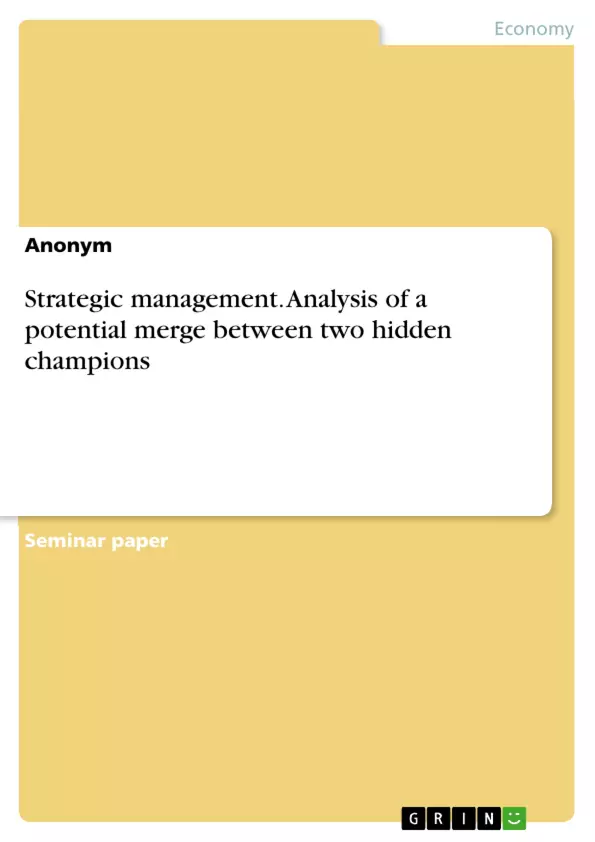Taking a closer look at two fictional companies, "Natura corporation" and "Wasserspiel GmbH & Co. KG", strategic options will be discussed which need to be considered for a possible merger of those companies by conducting a SWOT (Strengths, Weaknesses, Opportunities, Threats)-Analysis for both.
To identify their position in the competitive environment, a Stakeholder-Analysis will be developed and discussed. In a final step, Wasserspiel’s role as a hidden champion will be analysed along with a proposal, if it is of any benefit to continue a focussed strategy.
First, ground theories of strategic management will be explained, including a brief definition of what strategy is, followed by an overview of strategic management. As it is necessary for comprehending the subject of this paper, a detailed look on the strategic position analysis will be done by explaining the concepts of SWOT-Analyses and the Stake-holder-Approach. To conclude the theoretical fundamentals, an explanation of strategic choices will be given, followed by a detailed look on the benefits and risks of following a focussed differentiation approach.
The following chapter will conduct the SWOT approaches for both fictional companies, followed by a Stakeholder-analysis and their implications on both companies. Furthermore, Wasserspiel’s strategic choices towards a niche strategy will be discussed and conclude the chapter.
Being a young field of management theory, strategic management has become increasingly important over the last 20 years. While originally being handled by external consultant agencies, nowadays every - even small - company must consider its strategic and competitive approach. This is a result of the increasing competition due to globalization and digitalization and their impact on whole industries. Additionally, customers and suppliers have changing demands and expectations, creating an everchanging environment the business has to adapt to if they want to stay competitive.
To be able to adapt to these changing requirements and to be successful in the long term, strategic management offers a set of tools. Due to their vast complexity and quantity, it is necessary for the leadership team to know which of these tools and approaches fits their strategic needs and their intended strategic process.
Inhaltsverzeichnis (Table of Contents)
- 1 Introduction
- 1.1 Problem Statement
- 1.2 Hypothesis and Goal
- 1.3 Structure
- 2 Fundamental Theory
- 2.1 Strategy
- 2.2 Strategic Management
- 2.3.1 Strategic Position Identification
- 2.3.2 Stakeholder-Approach
- 2.4 Strategic Choices
- 2.4.1 Generic Strategic Choices
- 2.4.2 Focus Strategies
- 2.4.3 Hidden Champions
- 3 Preparation of a Merger
- 3.1 Identifying the Strategic Position
- 3.1.1 Compiling a SWOT-Analysis
- 3.1.2 Defining Stakeholders
- 3.2 Continuing the Focussed Differentiation
- 4 Discussion
- 5 Conclusion
Zielsetzung und Themenschwerpunkte (Objectives and Key Themes)
The main objective of this term paper is to explore the strategic options that need to be considered for a potential merger between two fictional companies, Natura corporation and Wasserspiel GmbH & Co. KG. This analysis aims to identify each company's strategic position by conducting a SWOT-Analysis and a Stakeholder-Analysis, and ultimately examine the viability of Wasserspiel's niche strategy in the context of a merger.
- Strategic Management Framework
- SWOT-Analysis and its Application
- Stakeholder Analysis and its Significance
- Focussed Differentiation Strategies and their Advantages
- Merger Considerations in a Competitive Environment
Zusammenfassung der Kapitel (Chapter Summaries)
- Chapter 1: Introduction This chapter introduces the topic of strategic management in the context of the increasing importance of competitive strategies in today's business environment. It sets the stage for the analysis of Natura corporation and Wasserspiel GmbH & Co. KG, highlighting the relevance of strategic management tools for assessing potential mergers. The chapter also outlines the paper's hypothesis and structure.
- Chapter 2: Fundamental Theory This chapter lays the theoretical groundwork for the analysis by defining the concepts of strategy and strategic management. It delves into the importance of strategic position analysis, explaining the methodologies of SWOT-Analyses and the Stakeholder-Approach. The chapter concludes with a discussion of strategic choices, focusing on focussed differentiation as a specific strategic approach.
- Chapter 3: Preparation of a Merger This chapter applies the theoretical framework to the case of Natura corporation and Wasserspiel GmbH & Co. KG. It analyzes the strategic position of each company using a SWOT-Analysis and Stakeholder-analysis. The chapter also examines Wasserspiel's strategic choices and discusses the potential benefits and risks of its niche strategy in the context of a possible merger.
Schlüsselwörter (Keywords)
This paper explores key concepts within the realm of strategic management, focusing on the strategic positions of companies, merger considerations, and the effectiveness of focused differentiation strategies. The analysis utilizes tools like SWOT-analysis, Stakeholder-analysis, and the concept of hidden champions to understand the strategic landscape of the fictional companies, Natura corporation and Wasserspiel GmbH & Co. KG.
- Citation du texte
- Anonym (Auteur), 2018, Strategic management. Analysis of a potential merge between two hidden champions, Munich, GRIN Verlag, https://www.grin.com/document/456422



